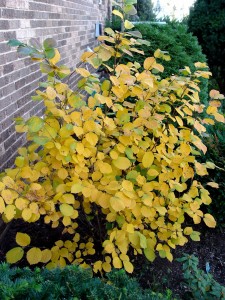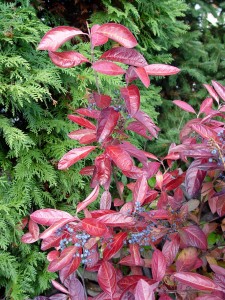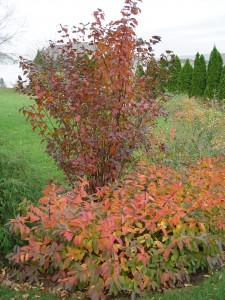Fall Foliage for the Yard
October 30th, 2008
People drive hours to see our region’s spectacular fall foliage.
And rightly so.
It’s a glorious sight.
But we gardeners can manufacture glory on a smaller scale right in our own yards by adding shrubs that turn brilliant color in fall.
Many of these are compact enough to fit in even small yards, and most are trouble-free, durable growers that also give us a decent flower show in spring.
So if your yard is finishing in a fizzle of dullness instead of a blaze of grandeur, try a few of these:
* Fothergilla. This native 5-footer is late to turn, but when it does, it pops like a neon light bulb exploding.
Depending on variety, the fall show can be glowing red, orange or yellow or a blend of all three. Fothergilla also gets white bottle-brush flowers in early spring.
Ideal site: Part shade and acidy soil.
Good varieties: ‘Blue Shadow,’ ‘Mt. Airy’
* Virginia sweetspire. Also a native, this shrub grows 3 to 5 feet tall, spreads by easily-controlled runners and gets arching white bottle-brush flowers in June.
The highlight, though, is the glossy scarlet fall foliage that hangs on for weeks – way longer than the better known burning bush.
Ideal site: Full sun to mostly shade, including wet soil.
Good varieties: ‘Henry’s Garnet,’ dwarf ‘Little Henry’
* Oakleaf hydrangea. Yet another native is this 6- to 8-footer that produces large hand-sized leaves shaped like maple leaves. It turns deep, rich burgundy in fall.
Oakleaf hydrangeas also produce large cone-shaped white flowers in summer and have interesting, peeling, cinnamon-colored bark to give them winter interest.
Ideal site: A fair amount of sun to part shade. Tolerates moderate drought.
Good varieties: ‘Snow Queen,’ ‘Snowflake,’ dwarf ‘PeeWee’ and ‘Sikes Dwarf’
* Crape myrtle. Most people try crape myrtles for their beautiful and long-lasting summer to early-fall flowers. But the fall foliage of this Southern favorite is way under-rated – typically glossy red or a red/gold blend.
Look for varieties that are winter-hardy to Harrisburg (Zone 6 or lower), and watch the sizes. Most types you’ll find here are large shrubs that grow to about 8 to 12 feet tall.
Ideal site: Full sun and a starring spot.
Good varieties: ‘Tonto,’ ‘Pink Velour,’ ‘Dynamite,’ ‘Red Rocket,’ ‘Hopi’ or the super-dwarf ‘Razzle Dazzle’ or ‘Filli’ series
* Witherod viburnum (Viburnum nudum). This gets my vote as the most attractive of the large viburnum family.
It’s got white spring flower clusters, glossy green summer leaves, then pink berries that turn blue, and stunning glossy scarlet fall foliage to top it all off. Figure on a size of 5 to 6 feet.
Ideal site: Full sun to part shade and can take damp soil.
Good varieties: ‘Winterthur,’ ‘Brandywine’
* Witch hazel. Another multi-season tall shrub better known for its very early yellow and orange flowers than for its neon red or gold fall color.
Witch hazels can grow into small-tree range of 20 feet, but they also can be maintained in large-shrub range of under 10 feet.
Ideal site: A woodsy area with shade, part shade or light sun and acidy soil.
Good varieties: ‘Arnold Promise,’ ‘Pallida,’ ‘Diana,’ ‘Jelena’
* Blueberries. Yes, the plant that gives us those tasty blue fruits in June and July also is a fantastic fall plant.
Have you ever seen one of these in October and November? The foliage turns bright red and glossy and is every bit as attractive as ornamental shrubs. The white, hanging, bell-shaped spring flowers also are nice, and it’s a bird favorite, too.
Figure on 4 to 5 feet tall and 3 feet around.
Ideal site: Full sun and very acidy soil.
Good varieties: ‘Patriot,’ ‘Herbert,’ ‘Blueray,’ ‘Blue Crop’
* Spirea Mellow Yellow. Make sure you get this particular spirea. Discovered in Tokyo by York County plant hunter Barry Yinger, Mellow Yellow has willow-like foliage that’s gold in summer and then changing shades of red, gold, orange and russet as fall winds down.
Arching stems are covered with white flowers in early spring before the plant leafs out. Figure on 4 to 5 feet tall and wide.
Ideal site: Full sun to part shade.
* Chokeberry. Another native and another multi-season performer.
The habit of most chokeberries is a little rangy, but in return they give us white spring flowers, bright red or black fall fruits and bright red or red/gold fall foliage.
Can go 5 to 10 feet tall and 5 to 6 feet wide.
Ideal site: Full sun to part shade and tolerant of damp soil.
Good varieties: ‘Brilliantissima,’ ‘Autumn Magic,’ the dwarf ‘Iroquois Beauty’
* Ninebark. People started growing this U.S. native once German plantsmen discovered a purple-leafed form.
Ninebarks get white late-spring flower clusters, then BB-sized red fruits, then dark foliage all summer, then fall foliage that turns bright copper. It tosses in peeling cinnamon-colored bark for winter interest.
Most grow 8 to 10 feet tall with a 6-foot spread.
Ideal site: Full sun to light shade. Tolerant of poor and dry soil.
Good varieties: ‘Diabolo,’ ‘Center Glow,’ ‘Coppertina,’ the dwarf ‘Summer Wine’
p.s. It’s not too late to plant yet. And you might find some of these on year-end clearance.
Why isn’t the popular burning bush on this list?
This form of non-native euonymus turns fiery red in fall, but it also has the bad habit of seeding into the wild, where it can crowd out many of our native plants.
Burning bush is a tough plant, but it’s a one-dimensional one, too. The main attraction is the red fall foliage. However, even then the leaves often blow off just a few days after they’ve turned red.










